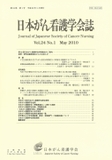Japanese
English
- 販売していません
- Abstract 文献概要
- 参考文献 Reference
- サイト内被引用 Cited by
要旨
本研究の目的は,在宅で生活する終末期がん患者とその家族の”家族の絆”について記述することである.研究協力者は在宅で終末期がん患者と生活する家族6名であった.データ収集は半構成面接ガイドを用いて面接法にて行い,質的帰納的に分析した.結果,【もう治らないという現実に向き合う生活】には,《変わりゆく患者の姿を受け止める》,《がん患者のやりきれない苦悩を受け止める》,《家族としての関係性の終わりを感じる》,《死にゆく患者を大切に思う》,《家族としての生きた証を感じる》,《最期まで共にいる》の6カテゴリーが抽出された.【家族固有の文化を刻む家族の方略】は,《家族らしいペースで生活する》,《がん患者が家族に託す思いを未来につなげる》,《がん患者が亡くなった後の生活を見通す》の3つのカテゴリーが抽出された.終末期を住み慣れた“家”で生活しているがん患者とその家族は,残された日々の中で家族として歴史を振り返り,家族として共に存在した証や家族固有のものを未来につなげようとしていた.
Abstract
The purpose of this study was to describe the family bonds of a terminally ill cancer patient living at home and his family. Six caregivers lived with the patient in the terminal stage of cancer. The study data was collected by semi-structured interviews and analyzed qualitatively. Six subcategories of family bonds were allocated as follows relating to living with the truth that the illness is incurable: 'acceptance of the condition of the patient fading fast', 'acceptance of the patient's feelings of anguish about the cancer', 'feeling the end of the family relationship', 'expressing love for the patient in the terminal stage of cancer', 'to feel the proof of having lived as a family', and 'to be with the patient until the end'. Three subcategories were found for the family strategy to maintain the culture particular to the family: 'to live at the pace characteristic of that family', 'to carry out the patient's wishes for the future', and 'to foresee family life after the patient has died'. The terminally ill cancer patient and his family now used to living together in the face of impending death intended to reflect back on their shared history as a family, reaffirm their existence as a family unit, and carry forward their particular family characteristics into the future.
Copyright © 2010, Japanese Society of Cancer Nursing All rights reserved.


